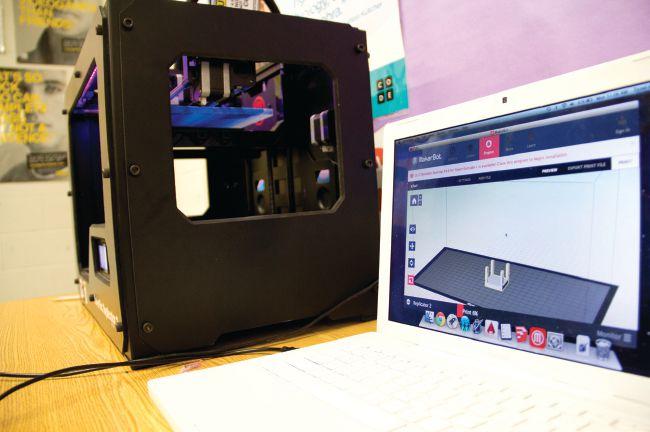
4 minute read
Learning in 3-D
from Maine Educator April 2016
by Maineea




When it comes to printing, many of us might just think, color or black and white? But for students in Jeff Bailey’s class at Mountain Valley High School in Rumford, printing takes on a life of its own— they’re doing it in 3-D.
“Besides visualizing on a computer you can create something and see it in the real world to get a prototype out of things you can make. It can be used for ideas and just for fun too,” said Sophomore Jacob Sinclair.
Jacob designed a Darth Vader model in the computer program Sketch Up (see page 13 for more) and then made that design come alive with the 3-D printer. The printer uses plastic, instead of ink, to create the models built in various computer programs. For Bailey’s students, living in a town where the paper mill is the primary employer, 3-D printing is opening new doors.
“I want kids to be creative. 3-D printing gets them to think visually and critically and helps them to become more successful with an area of their intelligence they don’t normally use in schools. This is an area that a lot of kids don’t know they excel in until they try it,” said Bailey.
The new hands-on tools in Bailey’s class are helping to reimagine what “shop class” used to be years ago, giving students the STEM learning experience they can then use to explore careers in science, technology and engineering. Bailey believes in helping shape a “maker mindset” where students can literally make something from nothing. “For some kids they’ll become architects or machinists but for other kids there is an awareness that this exists. I always remind them that everything they buy—someone designed it,” said Bailey.
With the 3-D printer, students are only limited by their imaginations, creating everything from ping pong paddles, to chess pieces, to chair models to car parts.
“My car had a missing piece from the air vent so I took it from “My car had a missing piece from the air vent so I took it from my car and designed a new one and printed it. I’ve always been my car and designed a new one and printed it. I’ve always been interested in science and space, so this has pushed my curiosity,” interested in science and space, so this has pushed my curiosity,” said Senior Alex Ridley. said Senior Alex Ridley.


Bailey, who used to teach English, also manages to weave in language Bailey, who used to teach English, also manages to weave in language arts lessons as well into his engineering classes. A recent project arts lessons as well into his engineering classes. A recent project asked students to redesign the school cafeteria, which required kids asked students to redesign the school cafeteria, which required kids to interview and study what students wanted. The process of making to interview and study what students wanted. The process of making



and designing through printing is catching on in a big way at Mountain Valley where students are now working on individual projects to design smartphone apps that would be useful to local community members. For Sophomore Ty-zel Knox, Bailey’s teachings and 3-D printing lessons have been transformative.
“It makes me want to become either an architect or an engineer. Both my parents work in the Dix eld mill. I thought I would work in the mill or somewhere else in town, but this has opened my mind to something more. The challenge of making something and being more. The challenge of making something and being able to make it, and 3-D print it is exciting,” said Knox.

In addition to 3-D printing in class, Bailey teaches Pre-Engineering, Art of Architecture, Engineering, Architectural Design and Exploring Technologies—they’re subjects which can translate to jobs in high demand and high pay.
“Sometimes it’s a struggle to get them past the challenges here,” said Bailey who says since he’s been an employee in the district he’s seen the free and reduced lunch rate jump to 80% of the student population at the high school. But even with the challenges there is a lot of hope and excitement around new ways to use technology, and ways to turn technology into opportunity. The proof Bailey says is in a recent student project that exceeded all expectation.
“I had a student 3-D print a game controller to control the game he designed and coded himself, which is like the trifecta of engineering,” said Bailey.



Week of Making
Just in the last two years the nation has taken on a leading role in advancing the “Maker Movement” to help students learn and grow in multiple fi elds. President Obama declared June 17-23 as the National Week of Making with this proclamation:
– President Obama, National Week of Making Proclamation To learn more about National Week of Making, log on to http://weekofmaking.org/.










